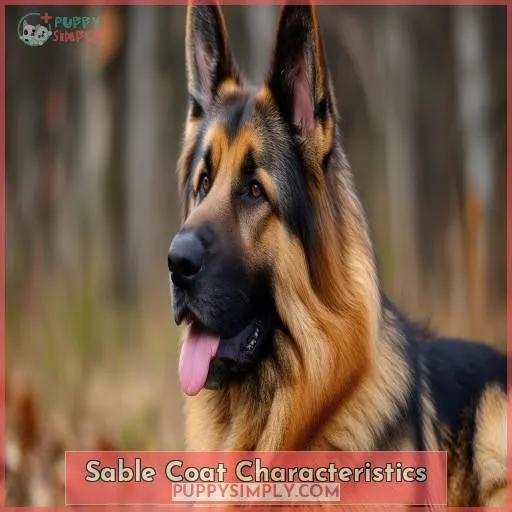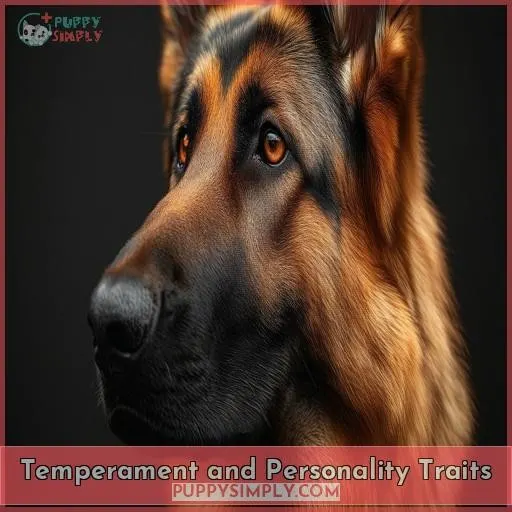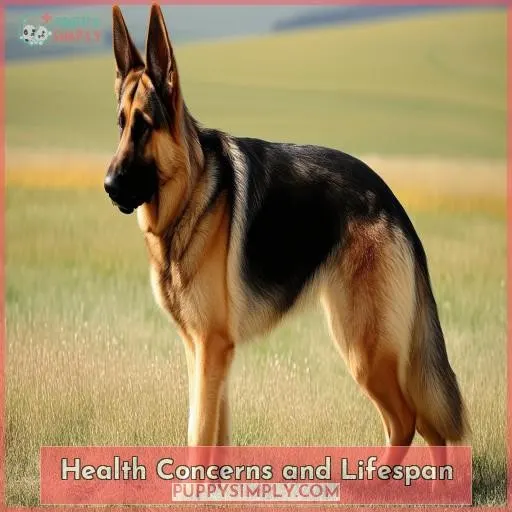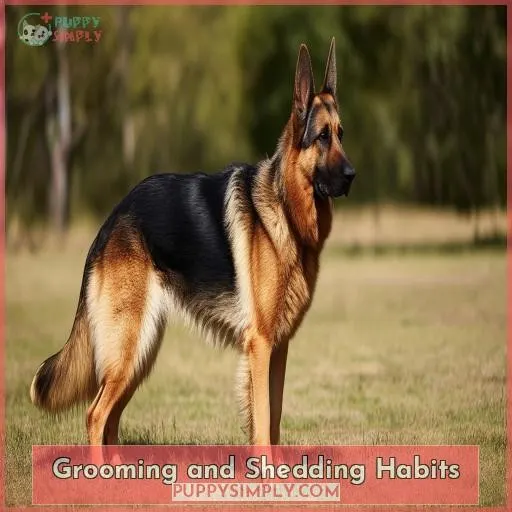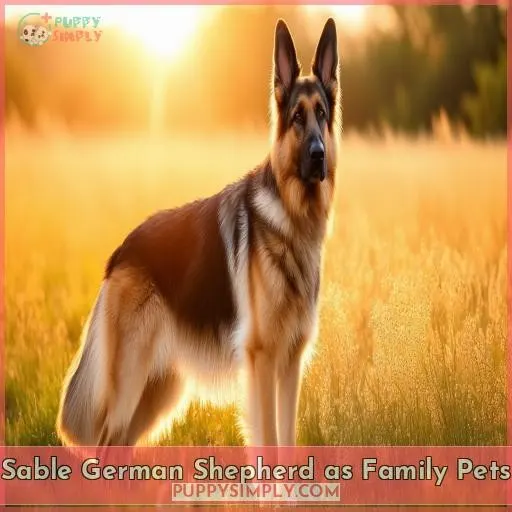This site is supported by our readers. We may earn a commission, at no cost to you, if you purchase through links.
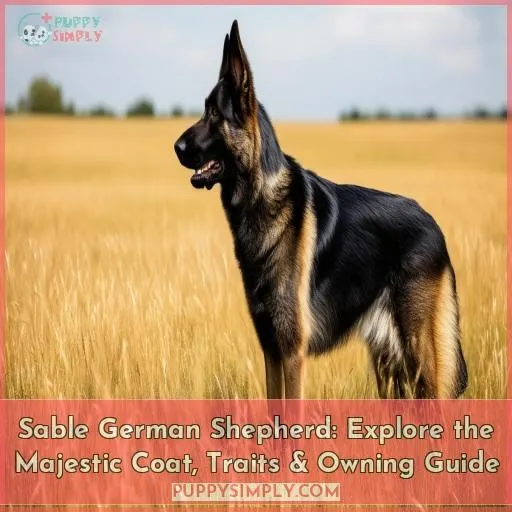 The sable German Shepherd boasts a unique coat blending tan or red hairs with distinctive black tips, creating a striking wolf-like pattern. This sabled appearance holds historical significance, as it formed the foundation for the breed through selective breeding by Captain von Stephanitz.
The sable German Shepherd boasts a unique coat blending tan or red hairs with distinctive black tips, creating a striking wolf-like pattern. This sabled appearance holds historical significance, as it formed the foundation for the breed through selective breeding by Captain von Stephanitz.
With their unwavering loyalty, intelligence, and protective instincts, sable German Shepherds make devoted companions. However, they require substantial daily exercise and proper training to thrive.
Uncover the majestic allure of this breed by learning about their exercise needs, grooming habits, and ideal family environments.
Table Of Contents
- Key Takeaways
- Sable Coat Characteristics
- Breed History and Origins
- Temperament and Personality Traits
- Exercise and Activity Requirements
- Training and Socialization Needs
- Health Concerns and Lifespan
- Grooming and Shedding Habits
- Sable German Shepherd as Family Pets
- Reputable Breeders and Costs
- Frequently Asked Questions (FAQs)
- What is a sable German Shepherd?
- How much does a sable German Shepherd cost?
- Do sable German Shepherds get darker with age?
- What is the rarest German Shepherd mix?
- How does the sable coat pattern develop?
- What jobs are sable German shepherds suited for?
- How do sable German shepherds compare to other breeds?
- Are sable German shepherds good with other pets?
- What are the challenges of owning a sable shepherd?
- Conclusion
Key Takeaways
- These magnificent canines boast a striking coat that looks like it was brushed by Mother Nature herself – a sable blend of rich tan and deep black that’ll make you stop and stare.
- Sure, their regal appearance commands attention, but sable German Shepherds are no mere pretty faces. With their unwavering loyalty and keen intelligence, they’ll guard your heart as fiercely as they would your home.
- Don’t let their wolf-like looks fool you – with proper training and socialization, these gentle giants make fantastic family companions. Just be prepared for a canine co-pilot who demands a daily dose of adventure and playtime!
- Bringing home a sable shepherd is a lifelong commitment, my friend. But for those willing to put in the work, the reward is a forever bond with a dog whose devotion knows no bounds.
Sable Coat Characteristics
The sable coat of the German Shepherd is a striking blend of rich colors and wolf-like patterns.
It features a base coat of lighter tan or red hairs, with the tips darkening to a deep black or charcoal hue.
This distinctive ‘sabled’ appearance creates a striking change from light to dark shades.
Genetically, the sable coat is dominant within the breed, making it a quintessential representation of the German Shepherd’s history and wolf ancestry.
While coat shades can range from light tan sables to deep mahogany reds, the hallmark black-tipped hairs are a defining trait that adheres to breed standards for the show ring.
Breed History and Origins
Looking back, you’ll find the sable coloration holds historical significance in shaping the German Shepherd breed. This rich, wolf-like coat caught the eye of Captain Max von Stephanitz, who identified the first German Shepherd, Horand von Grafrath, in 1899.
Von Stephanitz’s efforts to selectively breed these sable dogs laid the foundation for the modern German Shepherd. Initially employed as herding dogs, their versatility and intelligence quickly made them indispensable working companions.
From military service during World Wars to excelling in obedience competitions today, the sable German Shepherd’s journey through history underscores their enduring value as a show line and working dog breed.
Temperament and Personality Traits
You’ll find the sable German Shepherd to be a remarkable companion, epitomizing loyalty and intelligence. Here are a few key personality traits:
- Loyal to the core, forming an unbreakable bond with their family
- Independent thinkers, yet willing to please their owners
- Playful and affectionate, with unwavering protective instincts
- Highly intelligent, making training an engaging experience
These noble dogs crave being part of the family unit. Their protective nature, coupled with their loving demeanor, makes them superb family dogs. With proper socialization, their intelligence shines, allowing you to mold them into well-rounded companions. Embrace their unwavering loyalty and you’ll have a devoted friend for life.
Exercise and Activity Requirements
As highly energetic dogs, Sable German Shepherds require substantial daily exercise.
Aim for at least 60-90 minutes of rigorous activity like hiking, jogging, or playing fetch.
Their intelligence thrives on physical and mental stimulation through canine sports like agility, tracking, or scent work.
Backyard games involving searching or retrieving toys also satisfy their exercise needs.
Given their working background in roles like search and rescue, police, and military work, these dogs excel when their energy is properly channeled through sufficient exercise.
Failure to meet their exercise requirements can lead to destructive behaviors stemming from pent-up energy.
Training and Socialization Needs
Proper training and socialization are essential for sable German Shepherds. Enroll your pup in obedience classes and socialize them early with positive reinforcement training methods like treats and praise.
Teach basic commands like sit, stay, and come. Socialize them with people, animals, and new environments to prevent fear or aggression.
Positive reinforcement builds trust and confidence. Sable GSDs are receptive learners, so keep sessions fun yet consistent.
Socialization helps them become well-adjusted companions. With commitment to training, your sable GSD will thrive as an obedient, confident family member.
Health Concerns and Lifespan
With their striking appearance and strong build, sable German Shepherds require diligent monitoring for potential health issues.
Hip and elbow dysplasia are common inherited conditions, causing joint malformation and arthritis. Myelopathy, a degenerative spinal disease, is another concern, often seen in older dogs.
Reputable breeders screen for these issues, but regular vet check-ups are critical. Though generally robust, their lifespan averages 10-12 years.
Providing a nutritious diet, sufficient exercise, and maintaining an ideal weight can help minimize complications and promote longevity.
As with any purebred, research their unique health needs before committing to this magnificent breed.
Grooming and Shedding Habits
You’ll need to groom a sable German Shepherd regularly due to their double coat.
Brush weekly to remove loose hair and prevent matting.
During seasonal shedding, brush daily.
Their wiry outer coat repels dirt, but the softer undercoat captures dander and allergens.
Regular brushing prevents skin irritation.
Occasional baths help reduce shedding.
While grooming, check for skin issues, ear infections, and dental problems.
Proper diet, exercise, and grooming maintain their coat texture and conformation for dog shows.
They ensure a hypoallergenic environment for family pets.
Sable German Shepherd as Family Pets
You’ll find that sable German shepherds make excellent family companions, especially with children. With proper training and socialization from an early age, these loyal dogs can form strong bonds and become gentle, protective playmates for kids.
With Children
Regarding children, sable German Shepherds make exceptional family pets. They’re:
- Protective companions
- Gentle playmates
- Intelligent trainers
With appropriate socialization and positive reinforcement training, these dogs develop strong bonds. Regular playtime promotes healthy interaction patterns between kids and furry friends. Proper socialization averts any potential issues.
With Other Pets
Sable German Shepherds can coexist with other pets if socialized properly. Their Sable coat genetics, marked by gradual color changes from light to dark, add a unique look to their already wolf-like appearance. Early socialization and steady integration are keys to success to avoid dominance issues.
| Trait | Description |
|---|---|
| Socialization | Early, consistent |
| Temperament | Loyal, protective |
| Exercise Needs | High |
| Coat Care | Regular brushing |
Reputable Breeders and Costs
If you’re considering a sable German Shepherd, it’s essential to find a reputable breeder who prioritizes genetic diversity, health, and temperament.
Responsible breeders conduct extensive health screenings, ensuring puppies are free from hereditary conditions. They also evaluate temperaments to match puppies with suitable homes.
Expect litter sizes of 4-8 puppies, with pups costing $1,000-$3,500 from top breeders.
Verify the breeder’s credentials, view their facilities, and request health guarantees. Ethical breeders employ selective breeding practices, never overbreeding their dams.
With due diligence, you’ll find a healthy, well-socialized pup from a caring breeder committed to preserving the breed’s integrity.
Frequently Asked Questions (FAQs)
What is a sable German Shepherd?
A sable German Shepherd has a striking, wolf-like appearance–light roots with black tips create a gradual, light-to-dark coat color. These intelligent, loyal dogs aim to please their owners while exuding confidence and independence.
How much does a sable German Shepherd cost?
You can expect a sable German Shepherd puppy to cost between $1,000 to $2,500 from a reputable breeder. Prices vary based on bloodline, breeder reputation, and location. Be prepared for additional costs like supplies, training, and veterinary care.
Do sable German Shepherds get darker with age?
As the old adage goes, Like a fine wine, they only get better with age. Yes, sable German Shepherds typically darken as they mature into adulthood, developing a richer, more vibrant coat color over time.
What is the rarest German Shepherd mix?
The rarest German Shepherd mix? You’re talking about the noble Caucasian Ovcharka mix – a fearless, resilient guardian with a bear-like appearance. An enigmatic crossbreed that’ll command respect wherever it roams.
How does the sable coat pattern develop?
The sable coat’s lighter roots gradually darken as your pup grows. The tips of the guard hairs eventually turn black, creating a distinct change from light to dark.
What jobs are sable German shepherds suited for?
You’ll find sable German shepherds excel in roles like police and military work, search and rescue, herding livestock, and as service dogs for their intelligence and protective instincts.
How do sable German shepherds compare to other breeds?
The sable German shepherd barks up the right tree – they outshine most breeds in loyalty, intelligence, and versatility. Their wolf-like looks and brave nature make them stand out from the pack.
Are sable German shepherds good with other pets?
Yes, sable German shepherds can do well with other pets when properly socialized and trained from an early age. Positive reinforcement and slowly introducing them to other animals is key for a harmonious multi-pet household.
What are the challenges of owning a sable shepherd?
Sooth, owning a sable shepherd demands unwavering commitment – intensive training, exercise, and socialization are paramount for these high-energy, intelligent canines to thrive and avoid behavioral issues.
Conclusion
With their striking wolf-like appearance and renowned loyalty, sable German Shepherds demand substantial daily exercise and proper training. If you’re prepared to meet their rigorous needs, this majestic breed can thrive as a devoted companion. Remember, responsible ownership involves researching reputable breeders and committing to a lifetime of care for your sable German Shepherd.

